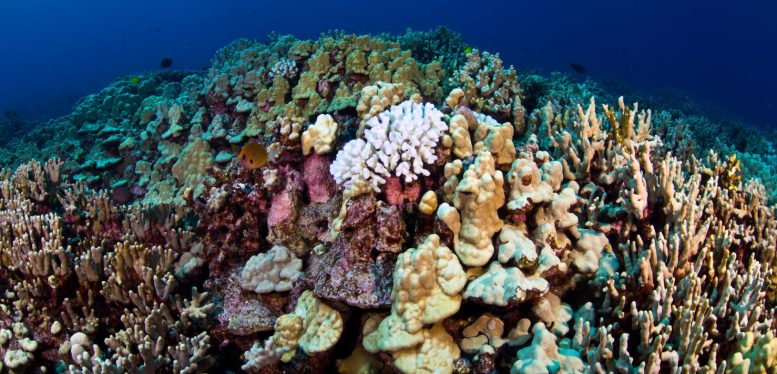
Research findings could help manage and build a resilient network of coral reefs.
As the world’s ocean temperatures rise, so will the number of cases of coral bleaching. When corals bleach, they become more vulnerable to other stressors such as water pollution. Many reefs, however, are home to corals that thrive despite warming oceans. Unraveling the complex issue of coral bleaching and its impact on their survival or death may be critical to conserving coral reefs — ecosystems on which more than half a billion people around the world rely for food, jobs, recreation and coastal protection.
For the first time, researchers have mapped the location of living corals before and after a major marine heat wave. In the new study, scientists show where corals are surviving despite rising ocean temperatures caused by climate change. The study also discovered that coastal development and water pollution have a negative impact on coral reefs.
In the study, published on May 2, 2022, in Proceedings of the National Academy of Sciences USA, Arizona State University scientists with the Julie Ann Wrigley Global Futures Laboratory reveal that different corals and environments influence the likelihood of their survival when ocean temperatures rise. The findings also demonstrate that advanced remote sensing technologies provide an opportunity to scale-up reef monitoring like never before.
From its home in the Hawaiian Islands, ASU researchers with the Center for Global Discovery and Conservation Science took to the sky on the Global Airborne Observatory (GAO). The aircraft is equipped with advanced spectrometers that map ecosystems both on land and beneath the ocean surface. With these maps, the researchers can assess changes in coastal ecosystems over time.
“Repeat coral mapping with the GAO revealed how Hawaii’s coral reefs responded to the 2019 mass bleaching event,” said Greg Asner, lead author of the study and director of the ASU Center for Global Discovery and Conservation Science. “We discovered coral ‘winners’ and ‘losers.’ And these winning corals are associated with cleaner water and less coastal development despite elevated water temperatures.”
When the Hawaiian Islands faced a mass bleaching event in 2019, the GAO mapped live coral cover along eight islands before the marine heat wave arrived. With these data, the researchers identified more than 10 potential coral refugia – habitats that may offer a safe haven for corals facing climate change. Among the potential refugia, there was up to 40% less coral mortality than on neighboring reefs, despite similar heat stress.
The results also indicated that reefs near heavily developed coasts are more susceptible to mortality during heat waves. When development occurs on land, the amount of pollution entering the reef ecosystem increases, creating an unfavorable environment for coral reefs already fighting to survive the warming water.
“This study supports Hawaii’s Holomua Marine 30×30 Initiative by not only identifying areas impacted by ocean heat waves, but also areas of refugia,” said Brian Neilson, study co-author and head of Hawaii’s Division of Aquatic Resources, “These findings can be incorporated into management plans to aid in building a resilient network of reef regions and sustaining Hawaii’s reefs and the communities that depend on them into the future.”
The Holomua 30×30 initiative aims to establish marine management areas across 30% of Hawaii’s nearshore waters. Coral reefs in Hawaii are integral to life on the islands, tied to culture and livelihoods. Understanding which corals are surviving is key to achieving conservation that is targeted and effective.
“Previous approaches have failed to deliver actionable interventions that might improve coral survival during heat waves or to locate places of heat wave resistance, known as coral refugia, for rapid protection,” said Asner, who is also director of the Global Airborne Observatory. “Our findings highlight the new role that coral mortality and survival monitoring can play for targeted conservation that protects more corals in our changing climate.”
Reference: “Mapped coral mortality and refugia in an archipelago-scale marine heat wave” by Gregory P. Asner, Nicholas R. Vaughn, Roberta E. Martin, Shawna A. Foo, Joseph Heckler, Brian J. Neilson and Jamison M. Gove, 2 May 2022, Proceedings of the National Academy of Sciences.
DOI: 10.1073/pnas.2123331119
The Center for Global Discovery and Conservation Science at ASU collaborated on this study with the Hawaii Division of Aquatic Resources and the National Oceanic and Atmospheric Administration’s Pacific Islands Fisheries Science Center. The Lenfest Ocean Program of Pew Charitable Trusts supported this study.
About ASU-GDCS
The Center for Global Discovery and Conservation Science at Arizona State University generates innovative scientific discoveries and outcomes that directly benefit environmental conservation, resource management and policy efforts. The center manages the Allen Coral Atlas and the Global Airborne Observatory among a diverse number of projects and laboratories and is based at ASU’s Tempe campus and in Hilo, Hawai’i.
The center is part of the Julie Ann Wrigley Global Futures Laboratory, the world’s first comprehensive institution dedicated to the empowerment of our planet and its inhabitants so that all may thrive. It is built upon the deep expertise of ASU and leveraging an extensive global network of partners for an ongoing and wide-ranging exchange across all knowledge domains to address the complex social, economic and scientific challenges spawned by the current and future threats from environmental degradation. ASU, ranked No. 1 in the U.S. and No. 2 Globally by the Times Higher Education Impact Rankings and No. 1 by the Sierra Club’s Cool Schools ranking for most sustainable university, empowers the Global Futures Laboratory to address critical issues related to the future of planet Earth.